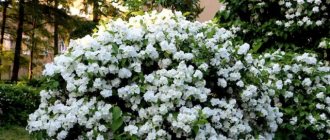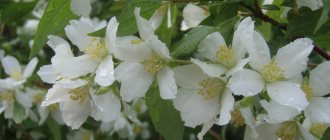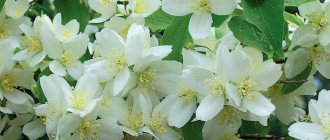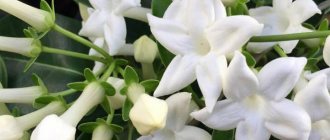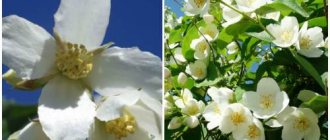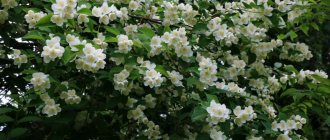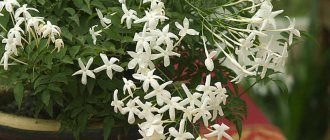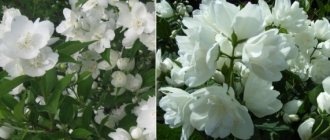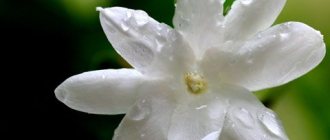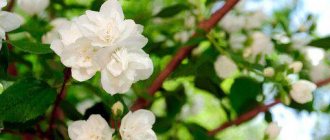Probably, almost every person knows what garden jasmine looks like and what it is. This plant is grown as an indoor plant by a very large number of gardeners. However, it can be grown in open ground. Many gardeners are happy to grow such a spectacular flower on their site. Jasmine bush can easily be confused with mock orange, and although these plants require almost the same care, they differ in appearance and also have significant differences in their origin. Thus, jasmine can be easily distinguished by its fragrant inflorescences, which are quite large in size.
However, in order to grow a spectacular and strong plant, you need to know how to plant it correctly in spring, and you also need to learn the rules for caring for garden jasmine. This kind of jasmine is a very beautiful plant, especially during flowering, when fragrant flowers bloom. But it requires good care, as well as proper planting.
Features of garden jasmine
It is quite possible to grow a plant such as garden jasmine in absolutely any area, but it should be remembered that it requires special care. Before you start growing this flower, you should first find out all the details about the care it needs. However, first you should learn more about this type of jasmine.
Garden jasmine comes from the Mediterranean. This plant has medicinal properties. However, most often it is grown as a decorative plant for decorating summer cottages and garden plots. This shrub has a very impressive lush crown. It is most beautiful during the flowering period, when yellow or white flowers bloom on the branches, collected in inflorescences. They are incredibly fragrant. Garden jasmine has a large number of different subspecies, which differ from each other in the size of the flowers. These plants stand out because they are able to adapt to almost any weather conditions.
Garden jasmine is quite undemanding about the planting site. So, it grows and develops very well in both sunny and shady places. It can be planted on both the southern and northern sides of the site. It tolerates both drought and high humidity quite well. Various insects, including most types of bees, love to collect nectar from the jasmine bush.
Varieties of crown mock orange (Philadelphus coronarius)
In the middle zone, the crown mock orange blooms first - in early June (if the spring is warm, then at the end of May). This shrub grows quite quickly and can reach a height of 3 m. The plant lives for about 30 years. The most commonly cultivated ornamental varieties in gardens are:
Aureus
In spring, this shrub with a spherical crown is decorated with bright yellow leaves, and in summer and autumn they are yellowish-green. Thanks to its bright foliage, this mock orange is decorative all season, and not just during flowering, when it is covered with numerous simple white flowers with yellow stamens in the center, emitting a strong aroma. Mock orange Aureus grows well in sunny areas, and tolerates partial shade, but then blooms sparingly. After flowering it needs sanitary pruning.
Variegatus
This upright shrub reaches a height of 1.5 m. In addition to creamy-white fragrant flowers, it has very attractive slightly serrated leaves (up to 5-9 cm long) of variegated (and some completely white) colors.
The uniqueness of garden jasmine
During the flowering period, flowers contain a large amount of essential oils, but only in those that have bloomed recently. They have a beneficial effect on human well-being. Benzyl alcohol and jasmine benzyl acetate can normalize human sexual libido. The buds of such a plant are used to make a special decoction that has the ability to normalize the functioning of the digestive organs. Also, the substances contained in garden jasmine can cleanse the body of toxins, as well as strengthen the immune system. Any of the varieties of such jasmine contains substances that have medicinal properties. The jasmine bush will not only become a magnificent decoration for your garden, but can also significantly improve your health.
In order for cultivation to be successful, you need to know at what time and how exactly to plant this flower in open ground.
Description
Mock orange is a plant from the Hydrangeaceae family. In Russia, the hollow shoots of this plant have long been used to make a chibouk - part of a pipe for smoking.
This shrub is popularly called jasmine because of the similarity of the aroma and color of its flowers with some varieties of indoor jasmine.
Popular rumor says that garden jasmine is the key to happiness and good luck.
There is a version that garden jasmine came to our country in the 17th century from Germany during the reign of the Romanov dynasty.
There are several versions of the origin of garden jasmine. According to one legend, an angel, wanting to make people's lives more beautiful, descended from heaven and turned into a jasmine bush. The ancient Greeks believed that the fragrant bush with charming white flowers was the work of the goddess of wisdom, Athena. Be that as it may, even now jasmine symbolizes love and evokes romantic associations.
The flowering time for mock orange is in the summer and lasts about three weeks. All varieties of this shrub shed their leaves in winter. The height of the shrubs varies: from seventy centimeters to 5 meters and above.
Main views with photos
Some species are the most popular among gardeners and summer residents.
Small-leaved jasmine
This is a fairly compact shrub that almost never reaches more than 100 centimeters in height. This plant has leaf blades that are quite large and curved. Its flowers have a very pleasant smell, reminiscent of strawberries.
Common crown jasmine
The shrub is quite large in size. So, it can reach a height of 250 to 300 centimeters. During the flowering period, such a jasmine bush is decorated with very large and beautiful inflorescences, which emit a pleasant sweetish smell. The leaf blades are painted a rich golden color.
Jasmine fluffy
This plant is recommended to be grown in parks or in fairly large areas. The bush can reach a height of 400 centimeters, and this is the tallest plant of all types of jasmine. However, the peculiarity of this plant is that its lovely flowers have no aroma. This species blooms quite late. Flowering lasts for 4 weeks.
Also very popular is the jasmine variety “Ermine Mantle”. This plant is quite compact and its height does not exceed 100 centimeters. Inflorescences are located along the entire length of the branches. Flowering lasts about 8 weeks.
Prevention of diseases and pests
Jasmine usually gets sick if the basic rules of caring for it are not followed:
- The shrub may be attacked by powdery mildew. The reason for the appearance of this pest is poor air circulation. The problem will be signaled by the appearance of a white coating on the leaf plates. To prevent the appearance of the pest, you need to use special preparations containing sulfur, potassium bicarbonate or myclobutanil.
- Sometimes jasmine roots can rot due to poor circulation of air masses in the soil, excessive watering or lack of a drainage system. In this case, you need to provide the plant with drainage, remove the wet soil and replace it with fresh one.
- When attacking aphids, you need to use special insecticides.
Jasmine is a shrub plant that almost anyone can grow in their garden or summer cottage. The plant is relatively unpretentious in care, but this does not mean that you should give up on the rules for growing it. If you follow the recommendations, this plant will delight you with lush and fragrant flowering for many years.
Choosing a suitable landing site
These species and varieties can be found in many gardens and summer cottages. As a rule, garden jasmine is planted in open ground in the spring. In order for the plant to grow and develop normally, you need to know several important rules for both planting and caring for it. As a rule, planting different types and varieties of garden jasmine is practically no different.
Key points in choosing a suitable landing site:
- When choosing a suitable place on the site for this plant, you should definitely take into account the fact that it can adapt to almost any weather conditions. However, if you want your plant to have a spectacular appearance and bloom very profusely, then it should be planted in a place that is protected from strong drafts. The fact is that they have an extremely negative effect on this shrub. Also, garden jasmine grows and develops better in a well-lit place with enough direct sunlight.
- This shrub is recommended to be planted in close proximity to flowers that have a purple or deep blue color tint. For example, it will look great next to delphinium or lavender. Jasmine also grows well next to hydrangea or spirea.
- Experts advise planting garden jasmine in the spring. However, this procedure can be carried out in the fall.
Comparison with mock orange and combination options
Mock orange and jasmine are unlikely to be found together. Cultures have too many differences. Evergreen jasmine grows in the southern regions, on loose soils, and loves shade and partial shade. Mock orange - cultivated in temperate latitudes, unpretentious to the composition of the soil, loves the sun.
The photo shows mock orange flowers, often called “garden jasmine”
Depending on the variety, the aroma of mock orange varies from jasmine to the unpleasantly bitter characteristic of hydrangeas. Another difference is the bark. The southern representative becomes woody when it ages, 5–6 years after planting. The mock orange immediately produces stems wrapped in brown bark. The wood of the unpretentious mock orange is hard and inactive.
The photo shows real jasmine flowers with elongated petals
The inflorescences of cultures also differ. Jasmine has straight flowers, mock orange has goblet-shaped flowers, and many varieties have semi-double and double flowers. Jasmine varieties cannot boast of such splendor.
Selecting the optimal soil and planting
Garden jasmine, as mentioned above, is a fairly unpretentious plant. But for its best growth, you should pay more attention to the choice of soil, as well as to its immediate planting.
- Due to its unpretentiousness, such a shrub is able to take root and grow well in almost any soil. However, whenever possible, preference should be given to soil rich in nutrients. It should be remembered that jasmine roots react extremely negatively to excessive humidity, so the choice should be left on a piece of land located at a not very high elevation.
- Sand mixed with small stones should be poured into the hole prepared for planting. This layer will act as drainage. When planting a plant in spring, it is recommended to pour nitrophosphate in the amount of 50 grams into the hole. This will allow the plant to quickly take root in its new location.
- When the bush is planted, the soil will need to be compacted a little. Then the jasmine needs to be watered.
- In order for the plant to develop correctly, it is necessary to systematically add fertilizer to the soil.
Selection of soil for fragrant shrubs
Despite the shrub's unpretentiousness to care, it is very picky about the soil. All its beauty is fully revealed only on fertile soils. It does not like swampy areas with stagnant water and feels comfortable on high slopes with preliminary drainage using broken bricks, crushed stone and gravel.
Preparing the planting hole
Proper planting of jasmine seedlings involves both the proper placement of the shrub in the garden and the preparation of the planting pit, taking into account the characteristics of the crop.
The dimensions of the hole for planting jasmine are 50*50 centimeters. In addition to drainage, the bottom of the pit is flavored with compost and a nitrophosphate mixture at the rate of 30 grams per seat.
When planting, you should pay attention to the location of the root collar; it should be buried no more than 3 centimeters into the ground. After planting, the soil near the seedling is compacted and watered.
As you can see, planting jasmine seedlings in spring does not require any complicated manipulations. However, after it it is necessary to follow agrotechnical rules for caring for young shrubs.
When to fertilize jasmine bushes?
You already know how to plant a jasmine seedling, but in addition to the nuances of planting, you cannot help but be interested in tips on proper plant care.
Rules for caring for this exotic plant include:
- feeding;
- pruning;
- preparation for winter.
We will tell you about them in more detail.
A year after transplanting the shrub into the ground, it is necessary to carry out a feeding procedure. Organic and mineral fertilizers are used, namely:
- superphosphate, urea, potassium sulfide in proportion to a bucket of water;
- slurry and wood ash diluted in a bucket of water.
Feeding rules
In order for your site to be decorated with a lush jasmine bush, you not only need to regularly care for it, but also systematically add fertilizer to the soil. It should be remembered that the very first fertilizing should be done only 12 months after planting the plant in open ground.
Garden jasmine needs minerals. To feed the plant, it is recommended to use a nutrient solution consisting of 1 liter of water and 5 grams of superphosphate. Add another 2.5 grams of urea and potassium sulphide into the resulting solution. After this, the solution is thoroughly mixed. It is used to fertilize this shrub.
Garden jasmine also needs organic fertilizers. So, it is recommended to use manure and humus for feeding. But it should be remembered that manure for feeding should be used only in diluted form, otherwise the plant’s root system may burn. It is recommended to dissolve manure in water in a ratio of 1:15.
How to maintain indoor jasmine
Home jasmine prefers acidic soil. Support the plant with mineral and potassium fertilizers, especially from mid-spring to late summer, as at this time the plant is actively gaining weight.
It is advisable to replant a young plant once a year, and an adult plant once every 3 years. In this case, be sure to use drainage and ready-made soil mixtures.
Trimming Features
In order for the jasmine bush to be lush and fragrant, fertilizing alone is not enough; it also needs to be properly cared for.
In order for the crown to always look well-groomed and impressive, regular formative pruning should be carried out. Both summer residents and gardeners have several secrets and rules regarding this procedure:
- formative pruning must be carried out in spring, when the shrub is in a vegetative state;
- the longest branches need to be cut off completely, and short ones should be shortened by ½ part;
- for more abundant flowering, rejuvenating pruning is carried out, or rather, all empty branches are removed;
- in an adult bush, the central trunk needs to be cut to 45–50 centimeters, while the rest are removed entirely.
Every year it is necessary to inspect the bush and remove damaged and diseased branches.
Problems when growing jasmine
If jasmine bushes grow very densely, they may develop powdery mildew due to insufficient air circulation. The first symptom is the appearance of a grayish coating on the foliage. As a preventive measure and for treatment, jasmine should be sprayed with fungicides that contain sulfur.
If the soil is not drained, the summer will be rainy, and root rot may occur. Diseased plants should be transplanted to a place with good drainage, cutting off the rotten parts of the rhizome and treating them with a fungicide.
Often the phenomenon is aphids. Of the pests, aphids are the most dangerous for this crop. Jasmine is sprayed with insecticides against insect pests.
Preparing for winter
In order for the plant not to die in winter, it must be properly prepared for this difficult period. To do this, you need to perform a few very simple manipulations:
- It should be remembered that adult specimens are more frost-resistant than young ones. Therefore, it is quite possible not to prepare adult plants for the winter period. However, those jasmines that are still quite young need this procedure.
- When the bush fades, it should be wrapped in material specially designed for this. You can also use regular straw for this purpose.
- To prevent jasmine roots from being damaged during the winter cold, in the autumn you need to dig up the soil around the trunk and do not forget to add compost to it.
- If desired, this shrub can be transplanted to a new place in the spring.
Seasonal care for indoor jasmine
Indoor jasmine is sensitive to changing weather conditions, and therefore requires different care in the summer and winter seasons. The plant does not tolerate dry soil and air, so during dry and hot periods it requires abundant watering and spraying.
In winter, humidification should be reduced and commensurate with the room temperature. It is important to maintain light moisture in the substrate, allowing the middle layer of soil in the pot to dry.
Reproduction methods
It is very easy to propagate garden jasmine. So, there are several ways:
- Seeds. Seeds are sown both in open ground and in a box at home (growing through seedlings).
- Cuttings. It is recommended to cut cuttings in the first days of June. They are then planted either in open soil or in a greenhouse.
- Escape. In spring, shoots should be prepared by separating them from the mother plant. The choice should be made on the strongest shoots. After they overwinter, with the onset of spring they are transplanted to a permanent place.
- Dividing the root system. This is not the most popular method of reproduction. It is recommended to divide in the autumn.
Unpretentious plants for the garden How to propagate mock orange or garden jasmine
You should also be sure to remember that indoor and garden jasmine are different crops, and each of them requires special care.
Jasmine in landscape design
Fragrant and easy to trim, jasmine is indispensable as a hedge. Low-growing varieties are successfully integrated into rockeries, alpine hills and ridges. Jasmine also looks great near bodies of water, reflecting picturesquely in the water.
Hydrangea and spirea go well with jasmine. Climbing plants with garden jasmine combine clematis, actinidia, and climbing roses.
Plot
0 votes
+
Vote for!
—
Vote against!
The aroma of jasmine is well known from childhood. A wonderful miracle in the parent's garden! A huge spreading bush with star-shaped snow-white and cream flowers attracts with its exotic and sweet smell. No other shrub has such a fragrant and pronounced aroma. The article will tell you how to grow jasmine in your garden.
In Latin, mock orange sounds like Philadelphus. The plant is named after Cleopatra's son, Ptolemy Philadelphus. All his life he loved fragrant flowers and incense. And people call it mock orange. In the distant past, a smoking pipe was made from twig-like straight shoots, part of which is called “chubuk”. The wood of the bush is hard, so it is used to make flutes, pipes and other crafts.
Jasmine planting and care
To grow a beautiful and neat plant, you should know and follow certain agricultural techniques.
- The plant tolerates shade, so it can grow both in shaded areas and in the sun. Planted jasmine in a well-lit place will bloom more abundantly and develop quickly.
- Planting jasmine seedlings can be done in autumn or early spring. These periods are favorable for the rooting and development of young plants.
Soil for planting garden jasmine
- Jasmine is not picky about the soil, but it can only reveal itself in all its glory on fertile soil. The shrub does not tolerate stagnant water, so it must be planted in a high area or by making preliminary drainage from crushed stone with sand, broken brick or gravel. The layer height must be at least 15 cm.
- For a seedling, you need to dig a hole 50 cm deep, fill it with fertile soil and add 30 g of nitrophoska. When planting, you need to ensure that the root system is not buried more than 3 cm into the soil. The soil around the seedling is compacted and watered abundantly.
Feeding jasmine bushes
- Feeding mock orange bushes begins a year after planting.
- Mineral fertilizers . For 10 liters of water you will need: superphosphate – 30 g; urea – 15 g; potassium sulphide - 15 g. All ingredients are stirred in a bucket of water and the contents are poured under 1-2 jasmine bushes. Faded shrubs should be fed by adding 15 g of potassium and 20 g of superphosphate to the soil.
- Organic fertilizers . Slurry has proven itself well. To prevent the plant from getting burned, organic fertilizer is diluted with water in a ratio of 1:10. It is recommended to carry out this feeding once a year. You can use birch or apple ash, embedding it in the soil under the jasmine. For one bush, it is enough to take 100 g of fertilizer.
Formation of a jasmine bush and anti-aging pruning
Often, tall varieties of garden jasmine acquire an asymmetrical shape, which is associated with different growth rates of the plant. To make it more neat, regular formative pruning will be required.
- You can give jasmine a beautiful look during the growing season. At the beginning of spring, when it becomes warm, it is necessary to trim long branches a little, and shorten weak ones by half. This procedure will enhance the active growth of young shoots.
- Over time, the bush grows, the branches become bare and choke the plant. Without a doubt, such a look does not decorate jasmine. Anti-aging pruning is required .
- With the arrival of spring, 4-5 trunks are shortened to half a meter, and all other shoots are cut to the ground. To prevent the development of fungal diseases, bare areas need to be treated. Garden varnish is a good remedy for plant protection. Mulch the surface substrate with compost and pour mullein infusion onto the soil. During the growing season, jasmine loves regular watering, 20-30 liters per adult plant.
- Young shoots grow from dormant buds. They are removed almost completely. It is recommended to leave only the 2-3 strongest branches on each stump. They will be the basis of the new bush. Within a year, jasmine takes on a decent appearance, and after 3 years you can enjoy flowering.
- Sanitary and cosmetic pruning is carried out every year. You should thin out the bush, remove excess shoots, and promptly remove flowers that have lost their attractive appearance.
Preparing jasmine for winter
- An adult jasmine bush does not need any additional preparation; it tolerates cold temperatures well. During the winter, the tops of young branches may become damaged, but in the spring, after formative pruning, jasmine quickly gains strength and is restored.
- But it is not so easy for young seedlings to withstand the winter cold, therefore, if the bush is not even a year old, it should be covered with light material and secured with rope in late autumn.
Jasmine planting and care photo
- In late autumn, the soil is dug up and covered with mulch near the plant trunk, as well as garden compost, manure or pine needles. This will prevent the root system from freezing.
- The garden shrub, thanks to its unpretentiousness in care and ease of propagation, has won the hearts of gardeners. An adult, beautifully flowering mock orange is the hallmark of the garden! Enchanting aroma, abundant flowering, snow-white and creamy, simple and beautiful, fluffy double flowers attract the eye of every passerby. You just want to stop, breathe in the unique aroma and enjoy the beauty of garden jasmine.
Methods for propagating jasmine
There are many ways to obtain a new specimen of your favorite variety. Garden jasmine is propagated by layering, woody and green cuttings, as well as seeds. The last method is time-consuming, quite labor-intensive and takes a lot of effort. Jasmine blooms only in 7-8 years.
Seed propagation
- Small, dusty mock orange seeds are planted in pre-prepared beds even before the onset of severe frosts. Sowing is carried out in December, when the snow cover rises above the site and reaches 15 cm in height.
- The seeds are planted in the soil and the beds are covered with spruce branches. During the winter they undergo natural stratification. In the spring, with the first rays of the sun, the snow cover will begin to melt and be absorbed into the ground, saturating the seeds with moisture. After some time, the first green shoots will appear.
- The quality of seedlings grown from seeds is quite high. They are less susceptible to diseases and tolerate harsh winters well.
Reproduction by layering
- With the onset of spring warmth, all shoots must be cut off from the mother bush. Over the summer, young shoots grow near the plant. The strongest and strongest can be used for reproduction.
- At the very bottom of the shoot, under the first developed bud, it is recommended to tie the lignified branch with copper or aluminum wire. This procedure will entail the formation of a root system. All that remains is to tilt the shoots towards the ground into pre-prepared shallow grooves. The shoot is placed in a hole and secured with wire in several places for good fixation. The grooves must be filled first with sand and then with peat.
- After just 1.5 months, new shoots will grow on the cuttings, which need to be covered with soil twice during the growing season. In the fall, they are shortened, separated from the mother bush and transplanted to a new place for growing.
Propagation by young cuttings
- June is the most suitable month for harvesting planting material. Which cuttings are suitable for propagation? If you take a shoot 10 cm long and bend it into a ring, it should not break.
- You need to start preparing the material in the morning; at this time the branches contain enough moisture. Under the lower bud they cut obliquely, and above the upper bud – in a straight line. The leaves are shortened by half; you should not tear them off completely.
- A greenhouse is the most convenient place for rooting young parts of shrubs. The substrate for plant development should consist of sand and weathered peat, taken in equal quantities. Before planting, it is recommended to keep the cuttings in a solution that promotes root formation for 20 hours. The planting depth is 3 cm. There should be a distance of 5 cm between the cuttings. The lower leaves should not be buried in the ground.
- For 2 weeks, to maintain moisture, it is advisable to spray the cuttings, shade them from sunlight and ventilate the greenhouse. You won’t have to wait long; after a while, whitish dots will appear, and then roots. At this time, it is necessary to gradually accustom the seedlings to the air. Young plants are grown in the garden bed.
- If it is not possible to propagate in a greenhouse, this can be done directly in the garden bed or garden. The cuttings are planted at an angle and covered with a cut plastic bottle. For the first 2 days, you cannot open the miniature greenhouse, and then daily ventilation is necessary so that the young seedlings do not burn out.
Propagation by shoots with dense wood
- In the fall, when the bush is free of foliage, shoots 15 cm long are harvested. They cut directly under the lower bud, and obliquely above the upper bud. The prepared branches are placed in a box, covered with sand and sent to a cool place for winter storage.
Important! In the spring, they begin planting overwintered cuttings in the garden bed. You can't waste time, the kidneys shouldn't swell!
- By autumn, the root system will appear and young shoots will develop.
Reproduction by dividing the root system
- This method is used only when you want to get another jasmine bush in a short time. To do this, you need to dig up the jasmine and divide the root system so that each plot has basal shoots. It is more convenient to divide the bush into parts using garden shears. Reproduction cannot be carried out during flowering; the best period is October.
What does jasmine suffer from and what pests can it damage?
Mock orange is a strong shrub; pests do not like jasmine. But it would be a good idea to inspect garden jasmine for insects from time to time. You can fight pests with folk remedies, of which a solution of laundry soap is the most effective.
Jasmine can be attacked by:
- weevil;
- aphid;
- spider mite;
- mealybug;
- soft false shield.
If folk remedies do not help, you can treat with insecticides.
Tips for caring for garden jasmine
- Weekly loosening of the soil;
- weed removal;
- use of organic fertilizers;
- mineral fertilizers;
- forming a bush, pinching the top to give the correct shape;
- timely watering, preventing the soil from drying out;
- removing faded inflorescences;
- thinning the bush as necessary, removing weak and old shoots.
- application of phosphate-containing fertilizers to enhance flowering.
Working on creating a landscape composition
- You can make a hedge from garden jasmine by planting shrubs along the perimeter of the site, at a distance of up to 1 m. The shrub grows well and if planted close to each other, you will get a thickened “wall” that will be difficult to cope with.
- In early June, the common mock orange . the small-leaved variety pleases with its fragrant flowers and passes the baton to a shrub with a translucent crown - Schrenk's mock orange . At the end of June, the odorless mock orange blooms. The name itself speaks for itself: the flowers of this variety are odorless, therefore they are recommended for people prone to allergies. Mock orange Lemoine is one of the most beautiful shrubs, finishing its flowering.
- Having collected a collection of various varieties on the site, which differ in their painted foliage and timing of bud blooming, you can contemplate their beauty for 2 months. Low-growing varieties are suitable for decorating a rock garden or rock garden; tall varieties can be planted in the center to create a background.
On a note! There are varieties of jasmine that are covered with flowers 2 times during the season. And from the low jasmine, which is used to decorate rock gardens, you may not even get flowers. Therefore, it is recommended that allergy sufferers keep low-growing species on their property.
- Garden jasmine with simple flowers looks beautiful next to lilac, but mock orange with fringed flowers is better planted separately from other plants. A single planting will make it stand out among other varieties.
Collection and drying of inflorescences
Happy owners of garden jasmine should learn how to collect flowers from a bush:
- The inflorescences are collected after full opening. At the same time, the time of collection matters: the gardener needs to catch it before sunrise. When exposed to sunlight, essential oils quickly evaporate from the surface of the leaf.
- The flowers are picked off, being careful not to damage the delicate inflorescences. Evaporation of oils will lead to the complete disappearance of the bactericidal effect.
A number of rules for drying jasmine flowers for tea:
- All twigs and leaves are removed from the collected flowers.
- The inflorescence petals are scattered in a thin layer on paper and left to dry. There should be no thermal effects - only wind and warm weather.
During the drying process, the petals are turned over several times to remove any darkened flowers. Properly dried buds remain exclusively white.
Mock orange diseases
Mock orange is mainly susceptible to fungal diseases - leaf spots and powdery mildew.
Brown spot . In the second half of summer, separate, rarely merging, light brown spots with a white border appear on the leaves. Later, small scattered brown dots form on them - sporulation of the fungus.
Gray spot . Usually, after flowering, large rounded ash-gray spots form on the upper side of the leaves, on which the fungus then develops sporulation in the form of concentric circles of small brown dots.
Blackish olive spot. In mid-summer, round, slightly convex spots appear on both sides of the leaves. At first they are blackish-olive, later brown with a black border. Soon, sporulation of the fungus develops from above in the form of small black tubercles.
Powdery mildew. In July, a white cobwebby coating of the mycelium of the pathogen with sporulation appears on the underside of mock orange leaves. Spores can infect new leaves until the end of summer. Over time, the plaque disappears or remains in the form of round spots. By August, the fruiting bodies of the fungus form on the mycelium in the form of small scattered black dots. They persist in winter on fallen diseased leaves. In the spring, spores ripen in them, again infecting the plants.
If mock orange bushes are affected by these diseases, fungicides are used: Bayleton, Tilt, Forecast, Maxim, Abiga Peak, Bordeaux mixture (1%) - according to the instructions.
In addition, branches may be affected by necrosis. In this case, diseased shoots are immediately cut out. In case of severe damage, it is better to get rid of the bush.
Mock orange pests
Aphid. On mock orange trees you can most often find beet or bean aphids, incorrectly called jasmine aphids. In spring and early summer, aphids live and feed on mock orange, and in the second half of summer they move to more tender herbaceous plants (beets, beans, sunflowers, potatoes). In September, they again fly to the mock orange and lay eggs at the base of the buds.
When damaged by aphids, the apical leaves of mock oranges curl, and the petioles and shoots become bent. When insects multiply en masse, the leaves become covered with honeydew, on which sooty fungi settle, which reduces the decorativeness of the plants.
If the number of aphids is small, you can wash them off with a strong stream of water from a hose and cut off the infested branches. Severely affected bushes are treated with insecticides - Biotlin, Tanrek, Karate or the biological preparation Fitoverm (4). Use according to instructions.
Spider mite . It causes damage mainly in dry seasons by sucking sap from young shoots and leaves. Damage to plants is observed in the second half of summer. Colonies of very small insects (length 0.5 - 0.6 mm), colorless or light green, multiply on the underside of the leaves, which become covered with a thin web and turn yellow. High air temperatures at this time are favorable for tick reproduction and contribute to the development of a large number of generations (up to 10). Before wintering, the color of the females changes to red. Only females overwinter under fallen leaves and plant debris, as well as in cracks in the bark.
For preventive purposes (if ticks are found on the site), plants are sprayed with infusions of garlic, chamomile, yarrow and other folk remedies. To suppress insects, acaricides are used - Actellik, Neoron, Fitoverm (4), etc.
Weevils. Insects are 5–7 mm long, the surface of the body is covered with light green scales with a metallic tint. The larvae and adults of the beetles gnaw holes of various shapes in the leaves or eat them completely, leaving only the veins. They also love to eat buds. Pests overwinter in the soil.
When weevils are detected, the bushes are sprayed with insecticides: Iskra, Fufanon Nova, Aktara, Alatar, Intavir (4) with adhesives (Liposam), or you can use “Green Soap”.
In the autumn, after leaf fall, it is necessary to spray the mock orange bushes and the ground underneath them with Bordeaux mixture (3%) to eliminate sources of fungal infection and wintering stages of insect pests.
In the spring, during the swelling of the buds, for preventive purposes it is recommended to spray the mock orange with a tank mixture of insecticide and fungicide - Hom + Fufanon (4).
Care
Garden jasmine is replanted in spring. To do this, you need to prepare the soil by digging a hole in it, the size of which should correspond to the volume of the root system of the shrub. The plant is transplanted into this hole, and the rules are similar to those that apply to planting such a shrub in the spring.
Watering
The plant especially needs moisture in the spring, before the flowering period, but most often at this time the soil receives moisture naturally. In case of a dry spring, moderate watering will be necessary. Mock orange should not be allowed to grow in constantly wet soil. It does not grow well in places where groundwater flows or in places where there is a constant supply of moisture. An adult plant tolerates Russian frosts and temperatures of +30...+40 degrees in the summer.
Freshly planted plants need abundant watering - 25-30 liters at a time. During periods of drought, water every other day; during rainy periods, once a week is enough.
Leaves are a good indicator of soil moisture. If there is a lack of moisture, they droop.
Fertilizers
To a greater extent, mock orange needs feeding during the period of its active growth, that is, in early spring, when it best absorbs nutrients. In the first year and only once, preferably towards the end of spring, 1 bucket of infusion consisting of water and slurry in a ratio of 10:1 must be added under the jasmine bush. In subsequent years, garden jasmine is fed exclusively with mineral fertilizers containing urea, potassium sulfate and superphosphate. Ash from an old fire is a good fertilizer for jasmine.
